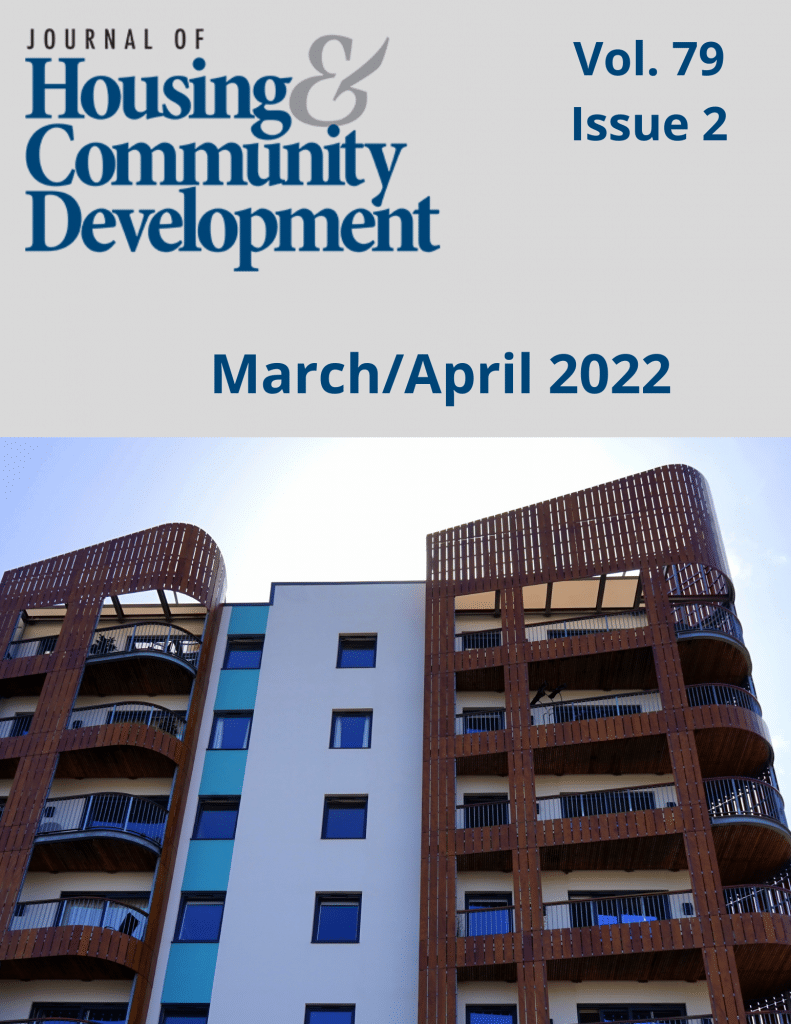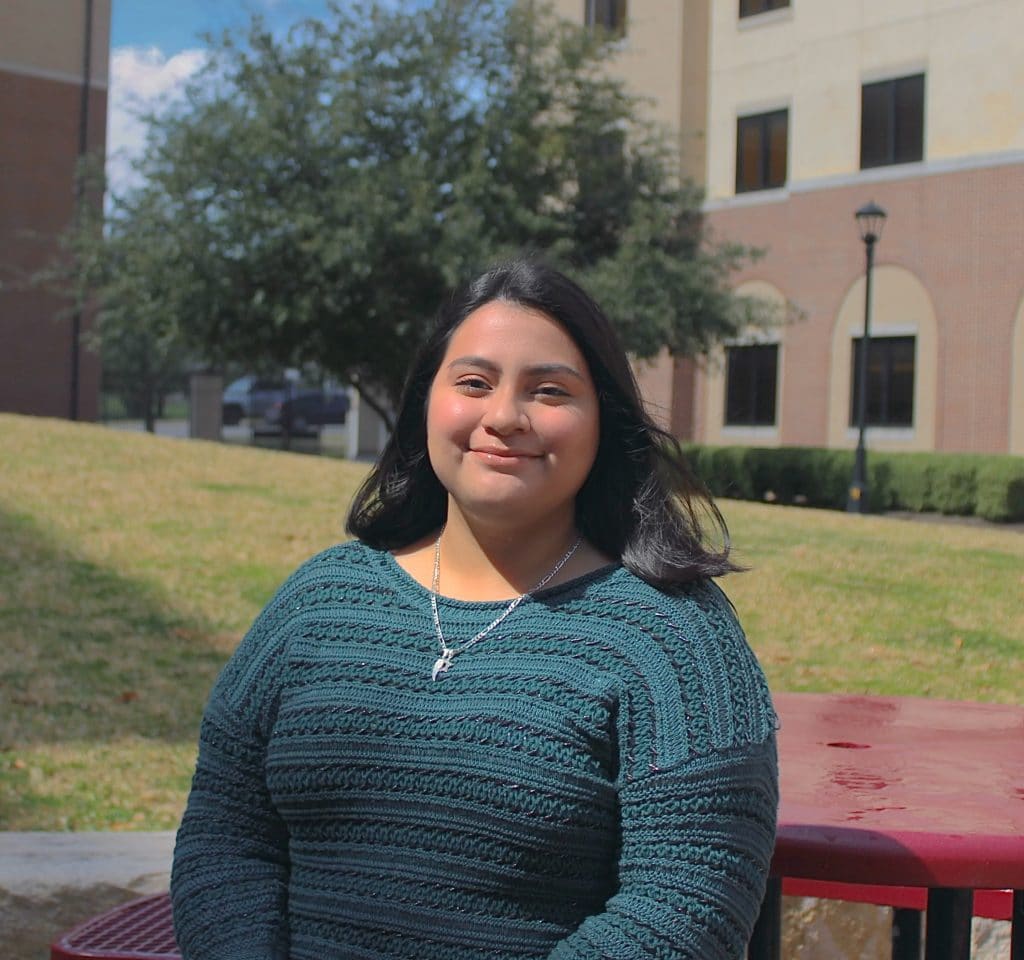Housers Build Bridges Over the Digital Divide
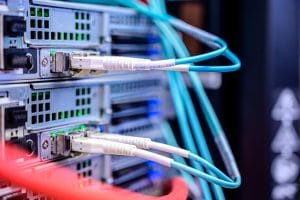
*This article was previously published in Shelterforce Magazine on March 29, 2022. You can view the story here.
The COVID-19 pandemic has accelerated an already steady shifting of essential services online—with 90 percent of U.S. adults saying the internet has been either essential or important to them, and 40 percent reporting that they have used technology in new ways over the last two years. As a result, access to a high-speed internet connection and a fully capable device has proven to be an essential lifeline to support health, stability, and economic well-being.
But for millions of people—a disproportionate number of whom are people of color—lack of access to connectivity has deepened health and economic inequities. Approximately 28.2 million (nearly 23 percent) of all households in the United States do not have high-speed broadband. While the lack of broadband infrastructure plays a significant role in this, 18.1 million of those households are not online because they cannot afford an available internet connection. The divide is starker among affordable housing residents, where about one-third of households lack home internet access; 80 percent of whom are unconnected because of affordability.
Given the growth of building-wide connectivity solutions, the ability to build and leverage trusted relationships between residents, onsite staff, and service partners to devise solutions, and the new resources available from the federal government, affordable housing and community development organizations are well positioned to narrow this digital divide. In early 2021, Stewards of Affordable Housing for the Future (SAHF), where we are both on staff, developed and published “Bridging the Digital Divide in Affordable Housing Communities: A Practitioner’s Resource for Multifamily Operators” which includes several case studies of short- and longer-term connectivity solutions implemented in the immediate response to the pandemic, and offers practical considerations for affordable housing organizations and their partners in seeking to connect residents to the wide range of digital access resources and services.
Understanding Existing Infrastructure and Increasing Building-wide Connection
Many organizations are implementing companywide mandates or have incorporated digital access into their strategic plans. For example, National Church Residences has integrated into its strategic plan an ambitious goal to ensure that 90 percent of the residents in its affordable housing communities have access to affordable internet service in their homes by 2025. “The digital road map is not clear or easy; it will require organizational commitment to move this initiative forward,” says Michelle Norris, executive vice president of external affairs and strategic partnerships at National Church Residences. “What is clear is that access to many of the social determinants of health resources will increasingly be accessed digitally, and that residents in affordable housing are blocked from such access. Solving this problem benefits all of us.”
Assessments
Organizations such as National Church Residences, Volunteers of America (VOA), and National Housing Trust have developed internal tools to track the existing infrastructure and connectivity capacities, as well as created frameworks that identify connectivity solutions by factoring in geographic location, building types and materials, available internet service provider (ISP) options, potential partners and funding sources, and an assessment of residents’ needs. According to Ryan Elza, vice president of innovation and technology for VOA National Services, “Volunteers of America prioritizes providing broadband infrastructure to provide internet access in-unit for residents and has conducted a needs assessment of our properties through a cross-collaborative team inclusive of development, asset management, property management, service coordination, and technology to identify the most cost-effective and practical solution.” The data from these assessments not only provides a better understanding of residents’ needs but can also be a tool for negotiations with ISPs on building-wide contracts. Resident survey tools can be adapted from existing tools like Eden Housing’s Technology Access Survey, Minnesota Literacy’s assessment form or BRIDGE Housing’s Digital Learning Survey.

Connectivity Solutions
The availability of high-speed internet is highly dependent on the physical infrastructure of properties and existing broadband infrastructure at the property and in the community. Since many affordable housing properties were built before the introduction of broadband internet, the physical design/structure often creates wiring challenges for owners who want to provide in-unit internet access to their residents. One of the challenges owners frequently encounter is exclusive wiring agreements with ISPs, which lock them into onerous long-term contracts and prevent other ISPs from entering their buildings, limiting residents’ access to and choice in providers. Many owners have overcome these challenges with innovative solutions.
Some owners are deploying cost-effective wiring techniques that provide building-wide access to residents. For example, Mercy Housing built an overlapping wireless network in a 106-unit property in Denver, Colorado, which consists of several wireless access points established in hallways, allowing for Wi-Fi signals that are strong enough to penetrate individual unit walls so residents can access the internet in their homes. Since these building-wide wireless networks require less cabling and drywall patchwork, they serve as a feasible and less expensive alternative to retrofitting existing buildings. Mercy’s model deploys a bandwidth of 500/20 Mbps which provides roughly 5 Mbps to each device if all units are using the service at once. Mercy Housing’s network is available to residents for free, and can be accessed through Chromebooks that are available through Mercy’s device-lending program (where an owner lends devices to residents). The cost for the overlapping wireless model of infrastructure depends on the size and building style; for Mercy the cost was $40,000 to $60,000 after accounting for labor costs. Though the upfront investment for a wireless network is higher than a short-term solution (like deploying mobile Wi-Fi hotspots) and requires some technological expertise, it reduces the ongoing costs for internet service to a reasonable amount that many property budgets can absorb. Mercy pays $331/month to provide internet service to residents which can be accessed using the Chromebooks made available through Mercy’s device lending program.
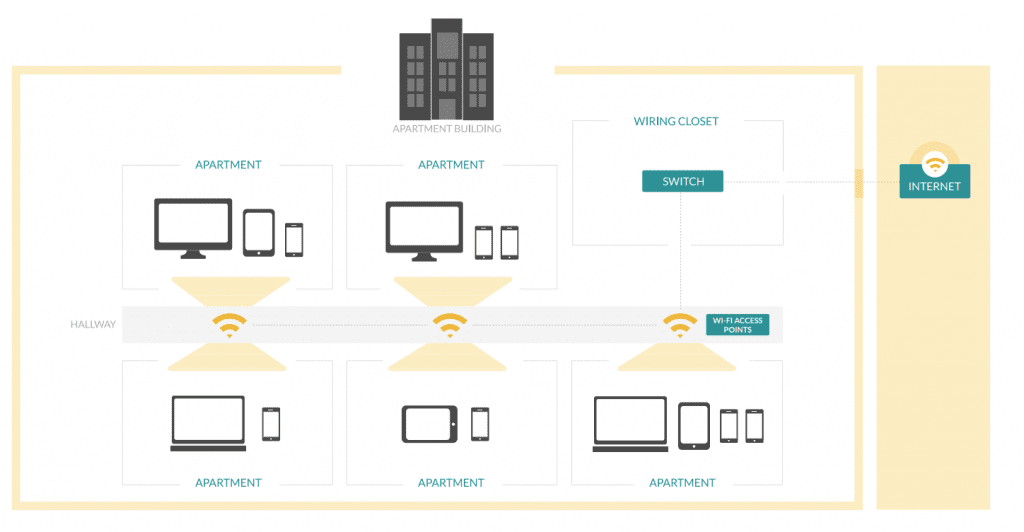
Additionally, a growing number of owners are working with smaller ISPs. Starry, for example, is an ISP operating in a growing number of markets that has built a model of providing low-cost internet specifically for affordable housing communities. Starry works directly with owners to install and wire their equipment in properties at zero cost and offers a minimum of 30 Mbps symmetrical speed to residents for $15/month, and depending on the size of the property and the number of households served, Starry is open to negotiating with owners for lower rates. Starry uses “hub and spoke technology”, in which antennas installed on top of buildings or towers beam high capacity, high-speed internet to receivers located on rooftops of apartment buildings. From there, the internet signal is connected using existing available building wiring to reach individual apartment units. Residents are then connected to the internet via a WiFi router located on the property, allowing Starry it to avoid many of the challenges that smaller ISPs face in gaining access to rights of way infrastructure to lay fiber or cable to the premise, a realm typically dominated by larger ISPs. In addition to the affordable service Starry Connect provides, it offers a host of additional programming components including marketing events and digital literacy training workshops. Starry waives some of the common barriers, such as running credit checks and requiring long term contracts, that residents face with many of the larger ISPs. However, smaller ISPs like Starry also encounter barriers to entry, given their limited geographic reach and the monopoly larger ISPs have in certain markets.
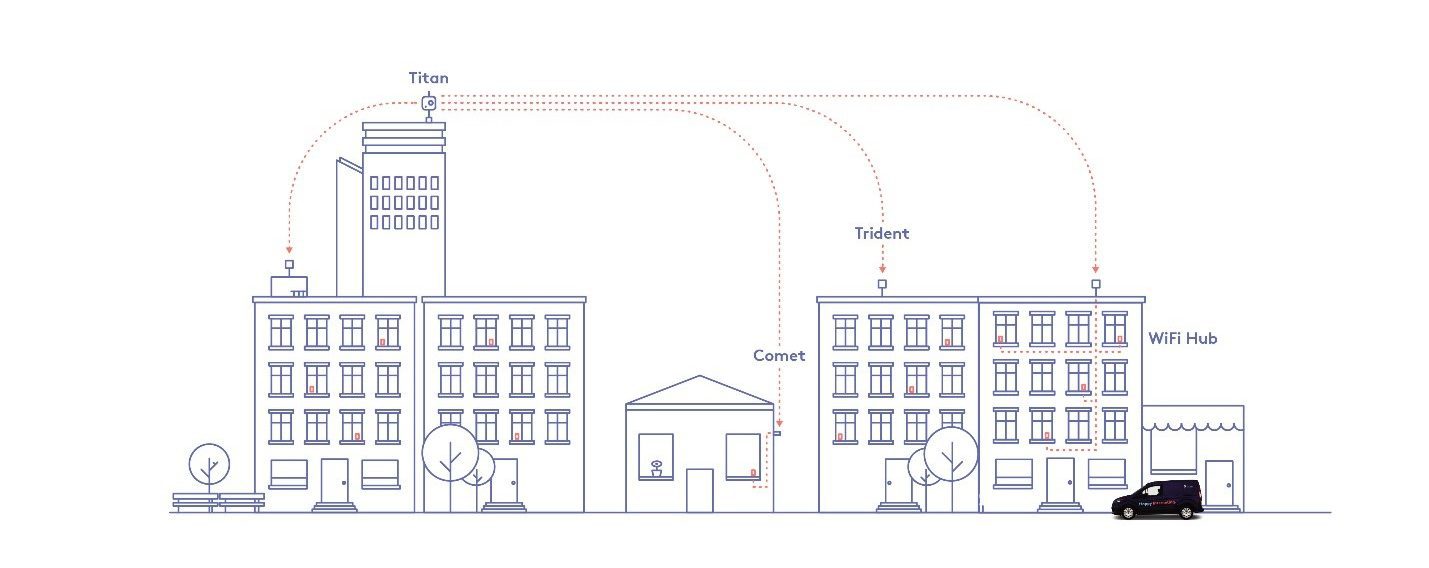
Increasing Access and Adoption
Resident services teams have an important role in supporting device-lending programs and helping residents navigate low-cost internet programs. These efforts are critical to addressing the digital divide, but organizations face significant financial and capacity constraints and cannot always support the maintenance of devices, engagement, and training that are required to meet residents’ needs. New federal resources, program models, and local initiatives can support these efforts.
For example, after the initial launch of the Emergency Broadband Benefit (EBB) program in 2021 (which provided eligible low-income households with a monthly discount of up to $50 on their internet service), many organizations were concerned about investing significant resources to help residents sign up for the program, given that the initial funding might only last for a few months. However, with the recent extension of EBB through the Bipartisan Infrastructure Law passed in November 2021, practitioners are now committing more staffing resources to promoting the Affordable Connectivity Program and facilitating residents’ enrollment.
Digital navigators can also assist residents navigate digital resources. These are individuals who address the whole digital inclusion process—home connectivity, devices, and digital skills—through ongoing engagement. Organizations are looking at digital navigator models that can be leveraged to either cross-train staff and/or identify and work with partners who operate digital navigator programs in the community. New federal resources (highlighted below) can be used by affordable housing and community development organizations to support digital navigation programs. As an example, National Housing Trust (NHT) has built a partnership with Literacy Minnesota, an organization that operates a national AmeriCorps VISTA program focused on digital literacy, to support a digital literacy and access program for residents in NHT properties. Through this partnership, NHT is ramping up some of its device-lending programs and navigation services and leveraging the AmeriCorps VISTA program to increase its capacity to support this initiative.
Others are also looking at how to make use of greater digital access to further their service delivery and resident engagement models. Throughout the pandemic, practitioners have reported that some programs transitioned more easily to virtual settings. While still evaluating these new delivery models, many believe that some housing stability, financial capability, and health programs could be more accessible and successful if offered with virtual options.
In addition to providing building-wide Wi-Fi solutions, cross-training some of their community health workers and resident services coordinators as digital navigators, and identifying partners to help provide digital skills training for residents, Volunteers of America National Services (VOANS) is piloting different technology platforms for reducing social isolation and supporting better aging in place. “Volunteers of America recognizes the transformative power of technology to combat social isolation and empower residents to age in community,” says VOANS’ vice president Ryan Elza. “Not only is the internet required to participate in the modern digital economy and education, it can also create a platform that will allow more low-income older adults to live independently longer by receiving healthcare services in their homes and help delay the transition to costlier long-term care.” VOANS’ pilot programs have included distributing voice-activated speakers and/or tablets preinstalled with a health and wellness portal, using HUD reserve funds to implement building-wide Wi-Fi, and building ongoing Wi-Fi costs into property operations. For example, at one property in Colorado where VOANS piloted voice-activated technology in 2020, resident services coordinators were trained to provide support and successfully connected 85 percent of residents as part of the voluntary program. VOANS is also seeking to add content on spirituality and brain health, among other topics, to promote wellness and aging in place. VOANS has integrated digital access into a number of its service coordination models, including its Aging with Options pilot program; and expects to expand digital engagement and service delivery models at other properties.
Policy and Funding to Support Increased Connectivity
Over the past two years, the federal government made historic investments to begin to address this need through COVID-19 relief bills, the American Rescue Plan Act (ARPA), and the Infrastructure Investment and Jobs Act (IIJA).
In March 2021, ARPA allocated $350 billion to state, local, territorial and tribal governments to respond to the COVID-19 pandemic and economic fallout. ARPA’s State and Local Fiscal Recovery Funds program provides flexible funding that can be used for broadband infrastructure and digital inclusion activities. As of November 2021, nearly half the states have allocated ARPA funds for broadband infrastructure and affordability programs. ARPA also established the Coronavirus Capital Projects Fund, which allocates $10 billion to states and territories to fund broadband projects that directly enable work, education, and health monitoring, with a prioritization for projects that promote digital equity. Nonprofits are eligible subgrantees of state funds and Treasury is in the process of reviewing the states’ applications for funds.
IIJA, which passed into law in November 2021, includes $65 billion for broadband deployment, affordability, and adoption programs. Funds will likely not be available for states to use until 2023, but many states are beginning to plan their use of funds, so housing providers should advocate with their state broadband offices now.
Low-Cost Internet Service
Many owners have helped residents access low-cost service by enrolling in programs such as Lifeline and the Emergency Broadband Benefit (EBB) program. IIJA provided $14.2 billion for low-cost internet services and device costs through the new Affordable Connectivity Program (ACP), which extends and amends the EBB Program, putting it on more permanent footing. Under the ACP, low-income households (households with an income below 200 percent of the federal poverty line) can receive a monthly discount of up to $30 on their internet service and apply this benefit to any plan of a participating ISP. Eligible households can also purchase one discounted device from participating ISPs. The ACP maintains automatic eligibility for household participating in several federal assistance programs and adds automatic eligibility for households participating in the Women, Infants and Children nutrition program. Unfortunately, this automatic eligibility did not extend to residents of federally assisted multifamily housing (see SAHF’s comments to the FCC). However, these additional resources provide longer-term access to affordable internet service for eligible families and many owners are promoting this program and helping to facilitate enrollment for residents.
Broadband Infrastructure
Under the Broadband Equity, Access, and Deployment Program (BEAD), National Telecommunications and Information Administration will provide $42.5B in internet infrastructure, access, and adoption funds through block grants to states and territories. Importantly, states must prioritize projects in unserved, underserved, and high-poverty areas. Many affordable housing properties are in these outlined priority areas and are well suited for investments in network deployment and broadband adoption. BEAD funds can also be used to deploy infrastructure and reduced-cost broadband within multifamily buildings with low-income households.
Access & Adoption Equity
The infrastructure law included the Digital Equity Act with grant programs that provide $2.7 billion to address adoption barriers to connectivity. Under the State Digital Equity Capacity Grant Program, states will develop and implement plans that promote digital equity, digital inclusion activities, and build capacity for adoption efforts. The Digital Equity Competitive Grant Program achieves the same goals as the state program; nonprofits can only apply for funds directly through the competitive program but can be subgrantees through the state capacity program.
Because BEAD funds can also be used for adoption activities, there is an opportunity for housing providers to design complementary programs to achieve states’ digital equity goals. The resources available through the Digital Equity Act funds would support more sustainable adoption solutions, such as forming partnerships on digital navigator training programs, bolstering resident services capacity, strengthening digital literacy efforts, and providing free or reduced-cost fully capable devices to residents.
Where Do We Go From Here?
Although we have known for quite some time that the digital divide exists and is more pronounced in low-income communities, the pandemic has spotlighted the effects of this divide and the importance of equitable digital access. Now is the time to close the digital divide, and for the first time, affordable housing and community development organizations have access to new resources to do this. With the new resources from IIJA, ARPA, and the growth of innovative connectivity models, affordable housing providers are well positioned to pursue scalable long-term solutions that address availability, access, and adoption barriers in their communities.
More Articles in this Issue
Build Back Better: A Priority to Preserve and Transform Affordable Housing in the US
Today, there are three core programs that compose the U.S affordable housing framework and support…NAHRO Announces Award of Excellence Winners
The National Association of Housing and Redevelopment Officials (NAHRO) recently awarded 18 prestigious Awards of…NAHRO Honors Legislators of the Year & Member Advocate
At NAHRO’s Online Washington Conference on March 28-30, the association recognized two Legislators of the…- Allergy Technologies
In Philadelphia, a Transformative New Program Eliminates More than 99% of Bed Bugs!
This article is sponsored content from Allergy Technologies. The Benjamin Franklin quote “An ounce of… Student Spotlight: Karen Medina
Stability was something Karen Medina craved her entire life. From a young age she moved…
